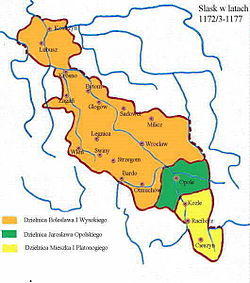Silesian duchy
| Duchy of Silesia | ||||||||||
|
Księstwo śląskie (pl) Herzogtum Schlesien (de) Slezské knížectví (cs) | ||||||||||
| Province of Poland | ||||||||||
| ||||||||||
| Capital | Wrocław | |||||||||
| Religion | Roman Catholic | |||||||||
| Government | Feudal monarchy | |||||||||
| Historical era | High Middle Ages | |||||||||
| • | Established | 1138 | ||||||||
| • | Duke Władysław II exiled |
1146 | ||||||||
| • | Split off Racibórz | 1172 | ||||||||
| • | (Finally) split off Opole |
1202 | ||||||||
| • | Split off Legnica | 1248 | ||||||||
| • | Incorporated by Bohemia |
1335 | ||||||||
| • |
Land of the Bohemian Crown |
1348 | ||||||||
| ||||||||||
The Duchy of Silesia (Polish: Księstwo śląskie, German: Herzogtum Schlesien) with its capital at Wrocław was a medieval duchy located in the historic Silesian region of Poland. Soon after it was formed under the Piast dynasty in 1138, it fragmented into various Duchies of Silesia. In 1327 the remaining Duchy of Wrocław as well as most other duchies ruled by the Silesian Piasts passed to the Kingdom of Bohemia as Duchies of Silesia. The acquisition was completed, when King Casimir III the Great of Poland renounced his rights to Silesia in the 1335 Treaty of Trentschin.
During the time of its establishment, the Silesian lands covered the basin of the upper and middle Oder river. In the south the Sudetes mountain range up to the Moravian Gate formed the border with the lands of Bohemia - including Kłodzko Land - and Moravia. After a more than century-long struggle, the boundary had just been determined by an 1137 agreement with the Bohemian duke Soběslav I. In the west Lower Silesia bordered on the German March of Lusatia (later Lower Lusatia) and the former Milceni lands around Bautzen (later Upper Lusatia) with the boundary running along the Bóbr and Kwisa rivers. Silesia was limited by the Polish provinces of Greater Poland in the north and the Seniorate Province of Lesser Poland in the east, separated by the Przemsza and Biała rivers.
...
Wikipedia


